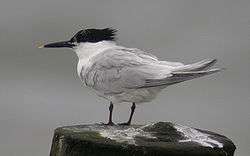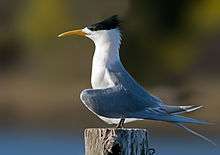Thalasseus
| Thalasseus | |
|---|---|
 | |
| Sandwich tern | |
| Scientific classification | |
| Kingdom: | Animalia |
| Phylum: | Chordata |
| Class: | Aves |
| Order: | Charadriiformes |
| Family: | Sternidae |
| Genus: | Thalasseus F. Boie, 1822 |
| species | |
|
T. bengalensis | |
Thalasseus, the crested terns, is a genus of six species of seabirds in the tern family. The current genus name is derived from Greek Thalassa, "sea".[1]
It has a worldwide distribution, and many of its species are abundant and well-known birds in their ranges. This genus had originally been created by Friedrich Boie in 1822, but had been abandoned until a 2005 study confirmed the need for a separate genus for the crested terns.[2]
These large terns breed in very dense colonies on coasts and islands, and exceptionally inland on suitable large freshwater lakes close to the coast. They nest in a ground scrape.
Thalasseus terns feed by plunge-diving for fish, almost invariably from the sea. They usually dive directly, and not from the "stepped-hover" favoured by, for example, the Arctic tern. The offering of fish by the male to the female is part of the courtship display.
These species have long thin sharp bills, usually a shade of yellow or orange except in the Sandwich tern and Cabot's tern where the bills are black with yellow tips in most subspecies. All species have a shaggy crest. In winter, the Thalasseus terns' foreheads become white.
List of species in taxonomic order

- Lesser crested tern Thalasseus bengalensis
- Royal tern Thalasseus maximus
- Greater crested tern or swift tern, Thalasseus bergii
- Chinese crested tern Thalasseus bernsteini
- Elegant tern Thalasseus elegans
- Sandwich tern Thalasseus sandvicensis
- Cabot's tern Thalasseus sandvicensis acuflavidus
An early Pliocene fossil bone fragment from the northeastern United States closely resembles a modern royal tern. It may be an unexpectedly early (3.7–4.8 million years before present) specimen of that species, or an ancestral member of the crested tern group.[3]
References
- ↑ Jobling, James A (2010). The Helm Dictionary of Scientific Bird Names. London: Christopher Helm. p. 383. ISBN 978-1-4081-2501-4.
- ↑ Bridge, Eli S.; Jones, Andrew W.; Baker, Allan J. (2005). "A phylogenetic framework for the terns (Sternini) inferred from mtDNA sequences: implications for taxonomy and plumage evolution" (PDF). Molecular Phylogenetics and Evolution. 35 (2): 459–469. doi:10.1016/j.ympev.2004.12.010. PMID 15804415.
- ↑ Olson, S., Rasmussen, P.C. "Miocene and Pliocene birds from the Lee Creek Mine, North Carolina" in Ray, C. E. & Bohaska, D.J. (2001). "Geology and Paleontology of the Lee Creek Mine, North Carolina, III." Smithsonian Contributions to Paleobiology, 90: 233-365.